
Published on 24 November, 2019.
In a previous post we took you birding along the beautiful Loma de Piedra trail in UNESCO-listed Alexander Humboldt National Park. This new post offers you further explorations of other excellent birding areas in and around the Baracoa region. You’ll notice they are beautiful natural areas to explore!
Semidecidous forests and dry evergreen forests such as those found in Humboldt Park and/or other protected areas in Baracoa are home to over 87 % of Cuban endemic species – and to a significant proportion of other West Indies’ endemic species that reside in our country. Check-out the endemic Tocororo (Cuban Trogon), Cuba’s national bird.

For their part, the dry Caribbean landscapes of the Southern coast between Guantanamo City and Baracoa are home to some rare and uniquely Cuban birds – and to other endemic fauna species not to be missed if you are a nature lover!

If you are a birdwatcher from Europe, Asia, Oceania or Africa, you will also be able to appreciate a good number of migrant species from North America that travel south and either stay in Cuba for the winter or transit through our country in the autumn and spring, such as this Hooded Warbler (Setophaga citrina, called Monjita in Cuba).

Birdwatching at El Yunque Protected Area
In this post we will tell you about three beautiful protected areas offering you rich birding experiences. Two of them are in Baracoa and the other one in the scenic neighbouring municipality of Maisi, where Cuba begins.
One such protected area is that of flat-top mount El Yunque, a favourite with Baracoa visitors mostly because of the wonderful hike to the mountain top and the amazing views from there. And for the delightful river Duaba waterfalls as well!

A few weeks ago, we spotted a West Indian Woodpecker (Melanerpes superciliaris, endemic to the Greater Antilles, called Carpintero Jaba’o in Cuba) from the top of El Yunque looking southward.

This protected area encompasses both family-run and cooperative farms that grow world-class organic cacao and other yummy organic crops, as well as beekeeping farmers producing delicious, flowery honey.
We were thrilled by this juvenile, endemic Cuban Oriole (Icterus melanopsis, called Guainuba in Baracoa and Solibio in other parts of Cuba) enjoying the fresh nectar of a banana blossom!

Noisy Smooth-billed Anis (Crotophaga ani, called Judio in Cuba) will enthusiastically announce your presence on any of the local trails and dirt roads.

From a habitat perspective, El Yunque protected area showcases semidecidous forests in some of the most striking karst formations in the region, as well as serpentine rock zones. That is why the vegetation, including wild orchids and tropical ferns varies widely – so as does the range of birds to be discovered.

Here are three species observed in different spots at El Yunque’s foothills. The first one is the Cuban Bullfinch (Melopyrrha nigra, called Negrito in Spanish), endemic to Cuba and the Cayman Islands.

The following species is the Red-tailed Hawk (Buteo jamaicensis solitudinis, which we call Gavilán de Monte), a subspecies endemic to Cuba and the Lucayan Archipelago.

And here you have the Cuban Oriole again, but as an adult in its full, deeply contrasting black-and-yellow plumage!
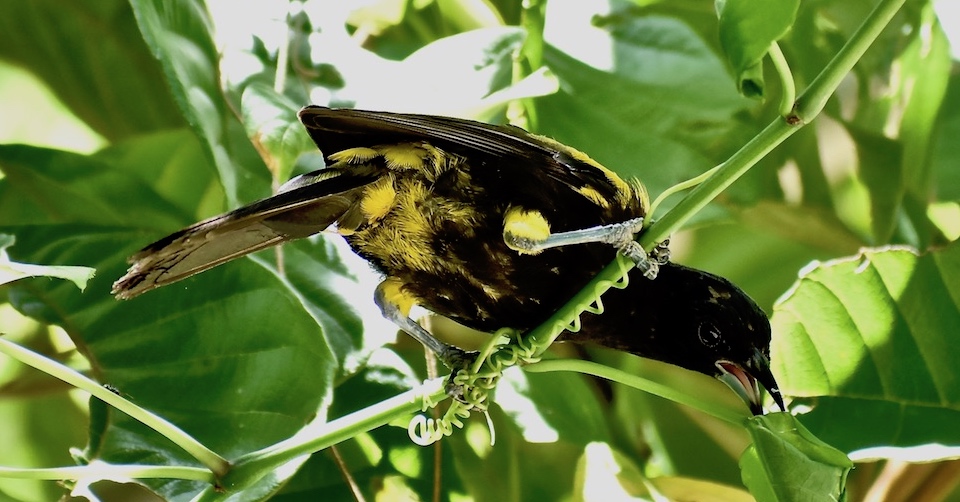
The Yara-Majayara Protected Area – Birdwatching Just Across Miel Bay
A few minutes from town and needing no transportation to get there, the Yara-Majayara Protected Area is a treasure trove for birders too, encompassing a mangrove at river Miel’s delta as well as dry evergreen forest vegetation and xeromorphic thickets on coastal karst.

Here you’ll see the colourful Western Spindalis (formerly known as Stripe-Headed Tanager), specifically the Cuban endemic subspecies Spindalis zena pretrei. We call it Cabrero.

Recently, we were able to spot several American Redstarts (Setophaga ruticilla), such as this male. In Cuba we call it Candelita.

This is another migrating bird, mostly active at dusk: the Antillean Nighthawk (Chordeiles gundlachii, called Querequeté in Cuba). It breeds in the summer in the Greater Antilles and then leaves this area in the autumn to winter in South America.

Here you have the Cuban Barn Owl (Tyto alba niveicauda). We spotted it in one of the limestone galleries that are typical of the Yara-Majayara protected area.

Woodpeckers abound in Yara-Majayara’s coastal karst. This infant Cuban Green Woodpecker (Xiphidiopicus percussus, endemic to our country and called Carpintero Verde in Spanish) startled us with its peculiar call as it perched on a rustic fence by a dirt road.

To get into the Yara-Majayara Protected Area, you must first pass through the tiny fishing and agricultural community of Boca de Miel, where river Miel meets the sea. It is home to a lively colony of egrets and herons thriving in the mangrove habitat.
We pictured this Cattle Egret (Bubulcus ibis ibis, or Garcita Bueyera in Cuba) very early in the morning, sitting high on a red mangrove tree top. Note its breeding colours in the deep pink bill and legs.

When the tide is low, it’s easier to watch a range of birds here too. The two following species are the Northern Waterthrush (Parkesia noveboracensis, a migratory bird which we call Señorita de Manglar) and the resident Tricolored Heron (Egretta tricolor, or Garza de Vientre Blanco in Spanish).



A boat ride around the estuary allowes us to photograph these other three species, including two resident and one migratory species, respectively: a Killdeer (Charadrius vociferous, or Frailecillo in Cuba), a Yellow-crowned Night-Heron (Nyctanassa violacea, called Guanabá Real in Spanish) and a Belted Kingfisher (Megaceryle alcyon, which we call Pitirre de Agua).



Before we take you to the third protected area we promised you, we should briefly showcase other places in Baracoa where we have spotted beautiful birds.
On the hills by crystal-clear river Las Minas we pictured this Cuban Peewee (Contopus caribaeus, endemic to Cuba and north-eastern Bahamas, called Bobito Chico in our country), a Yellow-billed Cuckoo (Coccyzus americanus, in Spanish Primavera), as well as a more mature individual of the Cuban Green Woodpecker species, mentioned above.
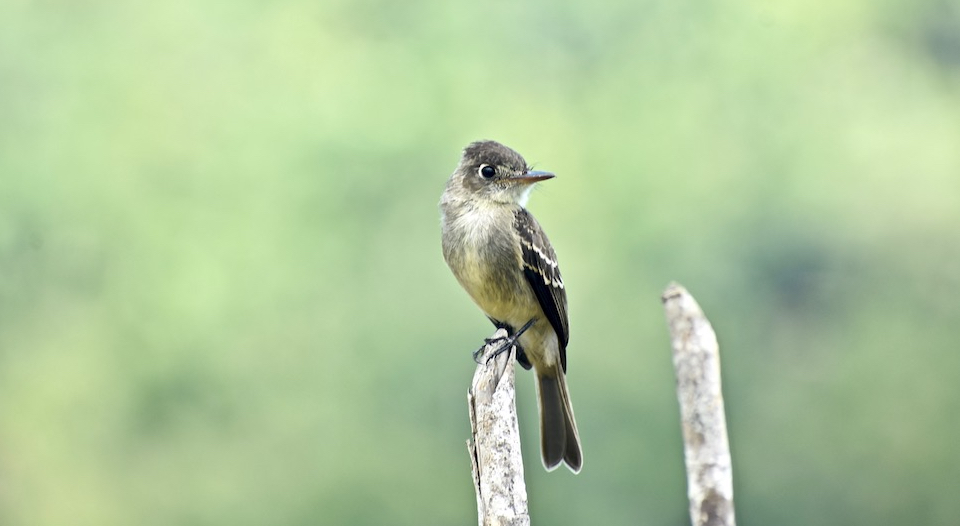

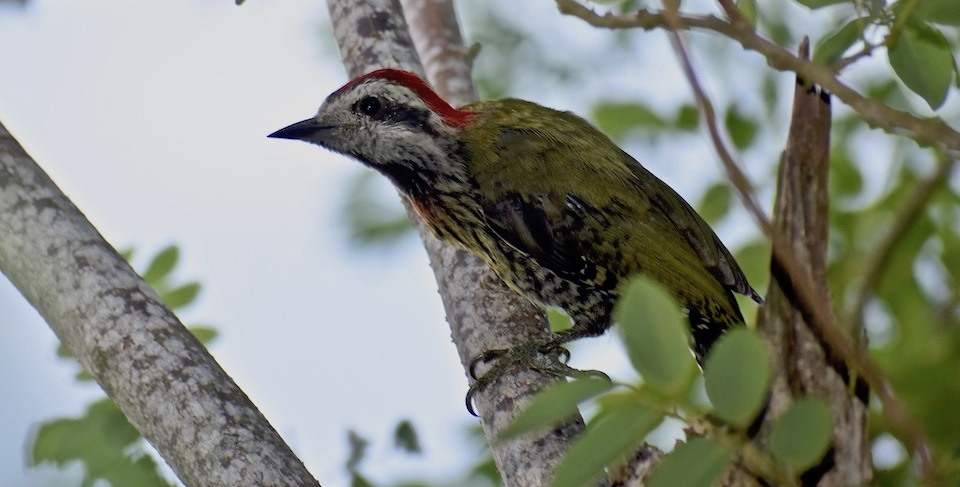
On a beautiful morning near the river Toa delta we spotted a Great Lizzard Cuckoo (Coccyzus merlini, endemic to Cuba and the Bahamas, called Guacaica or Arriero in Cuba), a Yellow-faced Grassquit (Tiaris olivaceous, in Spanish Tomeguin de la Tierra), a Northern Mockingbird (Mimus polyglottos orpheus, called Sinsonte in Cuba) and a Green Heron (Butorides virescens, which we call Matuango in Baracoa and Aguaitacaimán in other places in Cuba) .




Birding between Punta de Maisi and Pozo Azul
Welcome to Cuba’s Easternmost tip, the wild frontier land where the sun rises above our country! The Pozo Azul Protected Area and Trail features numerous bird species such as the endemic Cuban Tody (Todus multicolor, called Cartacuba in Spanish), the Black-whiskered Vireo (Vireo altiloquus barbatulus, which we call Bien-Te-Veo), the Cuban Emerald (Chlorostilbon ricordii, which we call Zunzun and is endemic to Cuba and the Bahamas) and the Loggerhead Kingbird (Tyrannus caudifasciatus caudifasciatus, in Spanish Pitirre Guatibere and a Cuban endemic subspecies).




Other species you can spot in this area include the migratory Ovenbird (Seiurus aurocapilla, called Señorita de Monte in Cuba) and the endemic Cuban Vireo (we call it Juan Chiví), more specifically its Eastern subspecies (Vireo gundlachii orientalis).


It is worth noting that the Pozo Azul sinkhole itself is beautiful – a perfect spot to chill after an early morning birding hike!

Punta de Maisi and Punta del Fraile are also choice areas for observing migrant shorebirds and other transient species including hawks, falcons and other large species. Here we see a Spotted Sandpiper (Actitis macularius, called Zarapico Manchado in Spanish) and a Black-bellied Plover (Pluvialis squatarola, which we call Pluvial Cabezón).


The coastline facing the Windward Passage, where Punta de Maisi and Punta del Fraile are located, offers magnificent landscapes.

For its part, the Maisi-Caleta Ecological Reserve boasts amazing geological terraces with xeromorphic thicket vegetation where a range of bird species live, including the lovely, endemic Cuban Gnatcactcher (Polioptila lembeyei, called Sinsontillo in our country – it can also be spotted within the sea grape trees between Pozo Azul and Punta del Fraile).

This female American Kestrel (Falco sparverious sparverioides, endemic Caribbean subspecies, white morph, called Cernicalo in our country) perched for a few minutes on an equally Caribbean Guaiacum officinale tree by the road.

On Your Way from Baracoa to Santiago de Cuba (or the Other Way Around)
Within the dry thickets between Imias and Cajobabo, the Cuban Grassquit (formerly classified as Tiaris canorusand very recently as Phonipara canora, a Cuban endemic genus and species called Tomeguin del Pinar in our country) is a favourite species of ours that can be spotted in groups and couples on smalls thorny trees.

Not far from there, in the area of Baitiquiri, another Cuban endemic and regional variation awaits: the Cuban Sparrow (Torreornis inexpectata, another genus and species endemic to Cuba which we call Cabrerito de la Ciénaga or Cabrerito Cubano). The Eastern Cuba geographical variety (Torreornis inexpectata sigmani) is not easy to spot, though. We tried once on our own and we failed – but the second time we were fortunate to count on a local guide’s support and we were finally fortunate to enjoy its subtle beauty!

Practical information and budget details
As you can tell from the previous paragraph, enlisting the services of the right guide for each birding area is of paramount importance for an optimal birding experience. There are experts in each of the three protected areas we focused on in this post. We’re happy to help our guests connect with them and book their excursion.
Access to all of Cuba’s protected areas requires a fee. The fee varies from one protected area to the other and, very often, from one trail to the other too. If you want details and practical information about each one of those protected areas, you can read each area’s own blog post, following the link provided in the paragraphs above.
In our previous post about birding in Baracoa, we offered our readers general tips and information about birdwatching in Cuba and in Baracoa.
A 5-Day Birding Itinerary in Baracoa and Surroundings
Day 1 – El Yunque Protected Area
An iconic landmark in Baracoa, flat-top mount El Yunque and its surrounding protected Area are a birder’s paradise. You’ll experience great sightings and take wonderful pictures from the summit, but also during your hike either to the mount’s top or on your way to the pristine river Duaba’s waterfalls. Splash into the latter’s natural pools to cool down at mid-day – you will never want to leave this place! (This certainly means you need to take your swim suit and flip flops with you, on top of your birdwatching gear!)

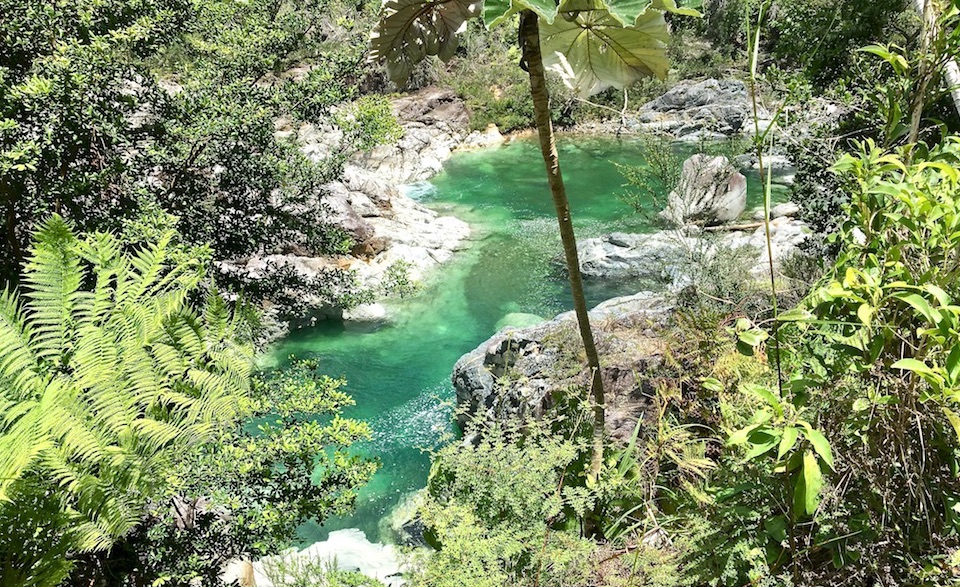
Day 2 – Yara-Majayara Protected Area
The most inexpensive birding excursion available in the Baracoa region, Yara-Majayara offers a great mix of habitats and landscapes. Its mangroves and river delta community (Boca de Miel) are idyllic, and its limestone terraces are unique and rich in flora and birds. Check out the sunrise view as you stroll around Miel Bay to make it there – or the sun setting behind El Yunque after you go birding there in the afternoon!
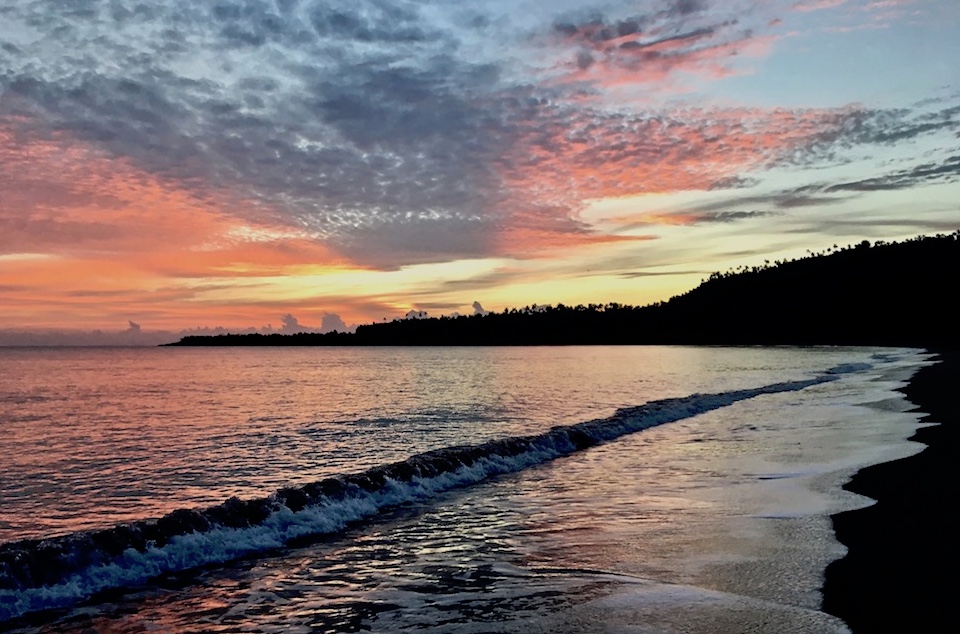

Day 3 Pozo Azul and Punta del Fraile
Pozo Azul is a real treat for the off-the-beaten-path nature and adventure lover. Together with Punta del Fraile, it offers a lovely birding experience including a mix of dry evergreen forest in coastal karst and rocky sea shore contexts. This area is where the sun rises first in Cuba – it takes an early departure from Baracoa to be there in time for the day’s initial chirpings and wing-flapping. Plus – the scenery itself is worth the trip and the hike!


Day 4 Loma de Piedra Trail & El Recreo Trail
This is the ultimate experience for birders exploring the Baracoa region! Located in Alexander Humboldt National Park, these two trails share a common patch offering a wide range of bird species in habitats such as serpentine soil semidecidous, charrascal and pine forests. With Loma de Piedra as the longest available trail offered in the park in one single day (8 km) and El Recreo as one of the shortest (2.5 km), you have a choice!
Having said that, other trails in Humboldt Park also offer excellent birding, such as the Balcon de Iberia trail, where we took this photo of the Cuban Pygmy-owl (Glaucidium siju, which we call Sijú Platanero), or the newly opened trail that leads to beautiful Fundadora beach, where we photographed this Yellow Warbler (Setophaga petechia, which we call Canario de Manglar)!


Day 5 On your way from Baracoa to Santiago de Cuba (or the other way around)
When you leave Baracoa (or when you come to it) by car, plan your private transportation to happen early enough to enjoy the amazing scenery and the unique birding spots for rare species including the Cuban Gnatcatcher and the unique Eastern variety of the Cuban Sparrow! Your trip will include the Sierra del Purial mountains as well as Guantanamo’s Southern marine terraces with their mix of dry evergreen forest, cacti and other xeromorphic spiny shrub habitats.


At Villa Paradiso
To close this post, five pics taken in our garden. The first one shows the Cuban Emerald (Chlorostilbon ricordii, endemic of Cuba and the Bahamas, called Zunzun in Cuba).
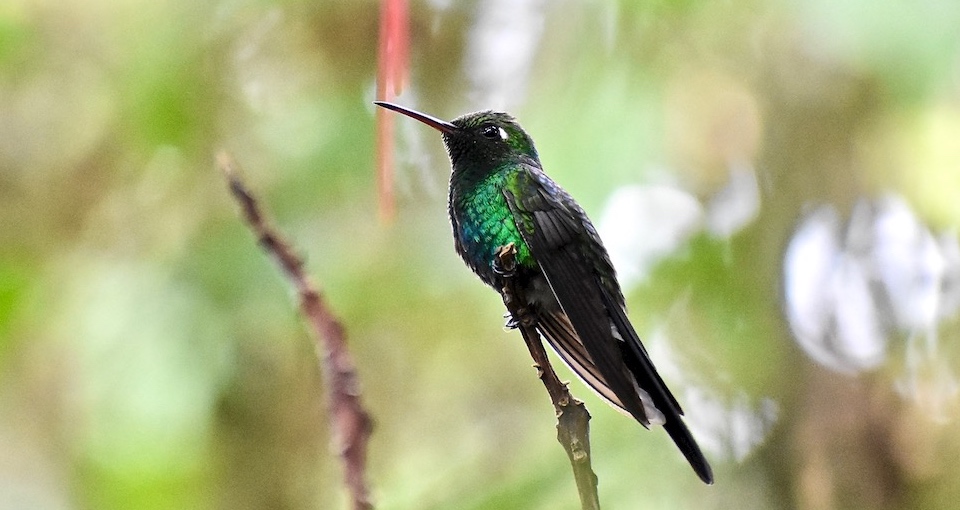
A close-up picture of the Red-legged Thrush (Turdus plumbeus schistaceus, subspecies endemic to Eastern Cuba, in Spanish Zorzal Real), quite abundant on our hill above town.

Another close-up, this one of an adult male of the Cuban Green Woodpecker.

To conclude, two migratory species: an American Redstart and a Black-throated Blue Warbler (Setophaga caerulescens), called Bijirita Azul de Garganta Negra in Spanish.

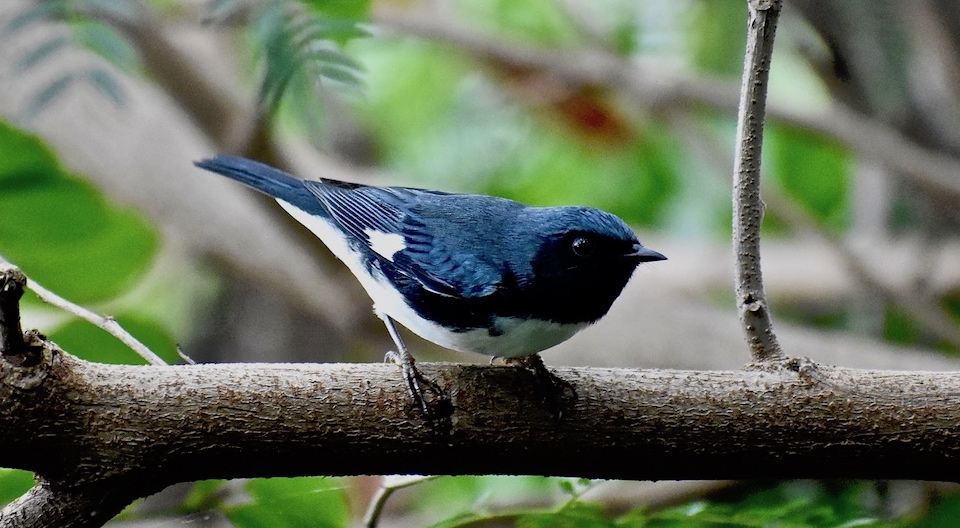
Activities, Baracoa, Sustainable Tourism
Tags: Adventure Tourism, Birdwatching, Ecology, Forests, Hiking, Nature Tourism, Off the beaten path, Rivers, Trails

Recent Comments
Wow!!!! You have become birders extraordinaire! These pictures are so fabulous, I am in awe. And you’ve provided a dream itinerary for birdlovers. It’s amazing how many endemic species you have. You might turn me into a birdwatcher ??
Thank you, Cynthia! Yes, we’ve improved a bit our bird photography skills. Or maybe we just became more patient. Or maybe the birds have decided to pose for us (even) more kindly! 😉 We’re super glad you enjoyed the pictures – we’ve discovered birding only recently and we can tell you it is wonderful for the senses and offers joyful experiences!
I’ve just started to become interested in bird photography. Your photos are incredible as I now have such admiration for bird photography as they are so hard to shoot. This is another reason for us to visit you.
Thank you, Wendy. We are fairly new to bird photography – we started end of April, 2019. We simply wanted to offer our website visitors better pictures to give them an idea of the birds in our region. We got immediately hooked on it – so much beauty in birds… 🙂 Soon we will be posting a new set of (more recent, better) pics, specifically of a range of Cuban endemic birds. Stay tuned! We are aware that Australia has amazingly beautiful birds too, so if you take to bird photography we’ll be super happy to enjoy your pics! (Some advice in case you haven’t heard: a 300 mm lens is pretty good for bird photography and there are some inexpensive models in the market – all our pics have been taken with a 300 mm lens). We’re looking forward to the time your family will come for a visit! 🙂
Why are birds always so much prettier in warmer climates?! We have mainly grey, brown, black and white here in the UK.
Thanks for stopping by, Stefan! I recently was in Toronto (quite a cold winter climate as you know) and loved the dazzling Northern Cardinal and Blue Jay (among other birds). You guys in the UK have absolutely lovely species such as the Great Tit, Blue Tit, Goldfinch, Chaffinch, Jay… the Long-tailed Tit is the most endearing thing! Apparently all of them are garden birds too – are you sure you are looking properly? 😉